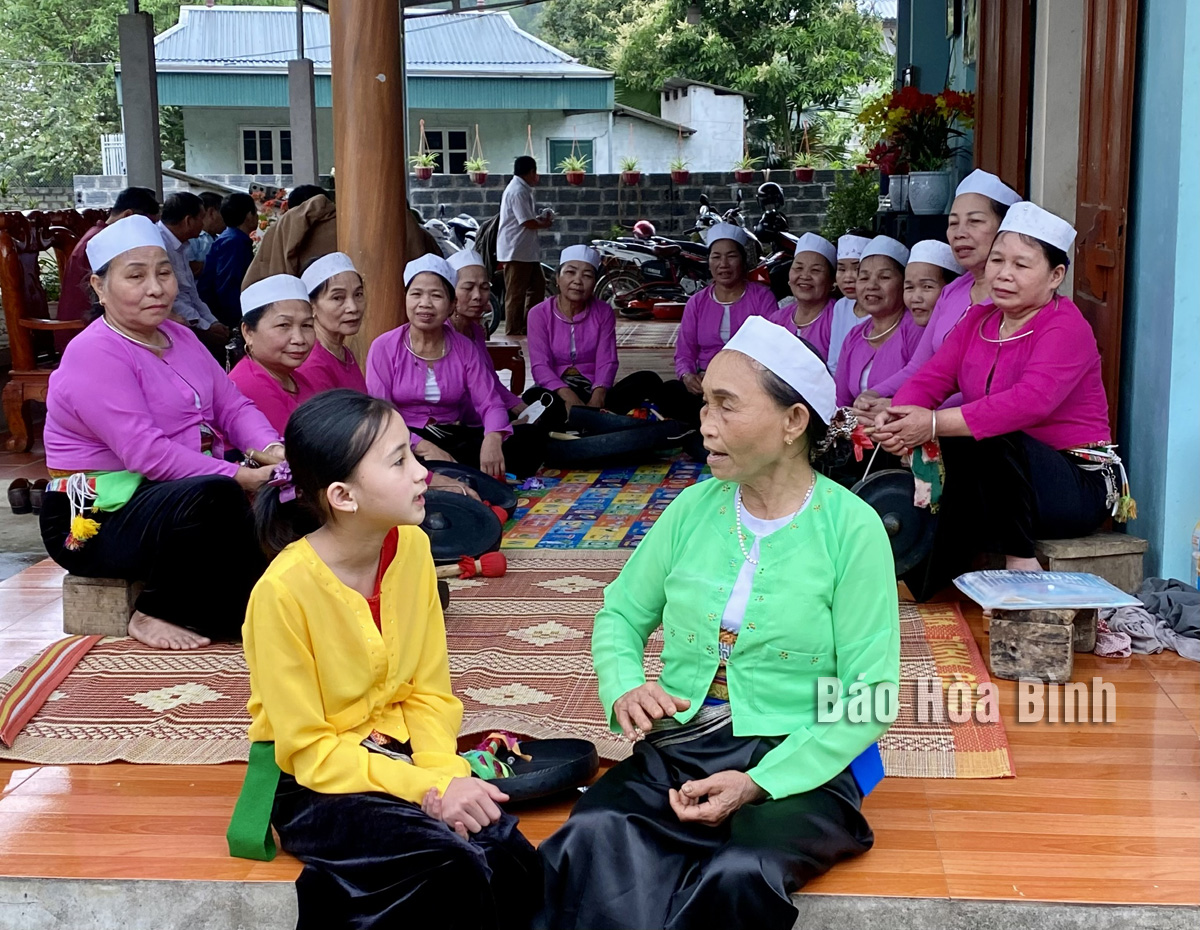



Meritorious Artist Bach Thi Dao in Beo hamlet, Xuan Thuy commune, Kim Boi district teaches Muong folk songs to a young girl.
Muong Vang, one of the four major Muong regions in Hoa Binh, is now Lac Son district which is home to ethnic minorities, mainly the Muong people. Notably, with a strong sense of traditional pride, the Muong Vang community has been actively involved in preserving both tangible and intangible cultural heritages, exemplified by traditional stilt houses, Muong gongs, Mo Muong (a job and also a performance practiced at funerals, religious festivals, and life cycle rituals by the Muong ethnic group), costumes, traditional crafts, folk games, and various forms of Muong singing.
In the district, there are approximately 18,000 Muong stilt houses preserved. In addition to conserving hundreds of ancient stilt houses, local people have researched and collected more sustainable materials to build houses while ensuring the preservation of cultural identity and minimising the use of natural timber. Lac Son is also one of the leading units in implementing cultural heritage preservation at the grassroots level, with vibrant activities from clubs dedicated to Muong mo, Muong singing, and Muong musical instruments.
Local artisans usually attend major provincial events. Recently, the district organised a sports dance festival themed "Welcoming the New Year 2025," featuring a performance of 1,050 women in Muong ethnic costumes; a campaign encouraging officials, civil servants, and students to wear Muong ethnic attire during festivals, holidays, and the first work or school day after the Lunar New Year holiday; and an "ao dai” performance with 2,000 women in ao dai and Muong costumes. These activities and events have received enthusiastic response from the community, contributing to raising awareness and responsibility for preserving and promoting valuable traditions.
The love for cultural heritage is also passed down from artisans to younger generations. Notably, artisan Bach Thi Dao in Beo hamlet, Xuan Thuy commune, Kim Boi district, has wholeheartedly teached Muong folk songs to dozens of young learners, including elementary and middle school students. Artisan Ha Thi Bich in Xam Pa hamlet, Na Phon commune, Mai Chau district, has offered free Muong singing classes at home and in the community centre, attracting many women and children. Artisans Bui Van Lung in Muong Lam hamlet, Phong Phu commune, and Bui Van Hung in Tru Bua hamlet, My Hoa commune, Tan Lac district, have passionately passed on Muong mo traditions to younger members.
Community voluntarily join heritage preservation
With the enthusiasm of youth, Bui Bao Du, head of the Four Muong Club, along with club members, initiated and called on the community to join restoring cultural heritage in Ram Co hamlet, Thuong Coc commune, Lac Son district.
In June 2023, the club and the local art team organised the first restoration programme featuring Muong gongs and singing.
In August 2024, the Ram Co community began restoring the Muong weaving craft, covering the entire process from silk cocoons to weaving, dyeing fabric, grinding rice for cake-making, and other recreative activities. The restoration gathered hundreds of artisans from Muong Vang and Muong Bi regions to share, attracting local residents and tourists to experience the unique cultural heritage in a natural setting.
According to Du, the restoration was entirely based on the voluntary spirit of the Muong Ram artisans. The community strives to restore at least one cultural heritage each year and has made plans for future restoration programmes.
In addition to restoration activities, many individuals and communities of Muong, Dao, Mong, and Thai minority groups in the province are eager to contribute to preserving their cultural heritage. For instance, Bui Thanh Binh in Thai Binh ward, Hoa Binh city, established a private Muong Cultural Heritage Museum. Bui Tien Xo in Vinh Tien commune, Kim Boi district, keeps many ancient Muong gongs and teaches others how to play them. Ly Van Henh in Sung hamlet, Cao Son commune, Da Bac district, preserves and teaches Nom - Dao scripted.
The efforts of artisans in teaching heritage, the development of clubs preserving ethnic identity, and promotional activities on social media platforms like Facebook, YouTube, TikTok, and Instagram enrich the ways to preserve and enhance heritage values.
Bui Xuan Truong, Deputy Director of Hoa Binh province’s Department of Culture, Sports, and Tourism, said authorities at all levels always pay attention to and support the community’s heritage preservation efforts. Through restoration and preservation efforts, the community asserts its aspirations and central role in cultural activities, helping to reduce pressure on the government and enhancing community responsibility in inheriting and promoting cultural heritage values.